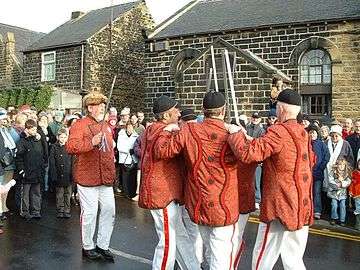Grenoside
Grenoside is a suburb of Sheffield, South Yorkshire, England. The suburb falls within the West Ecclesfield ward of the city.
| Grenoside | |
|---|---|
 Grenoside Location within Sheffield | |
| Population | 4,177 (2001) |
| Civil parish | |
| Metropolitan borough |
|
| Metropolitan county | |
| Region | |
| Country | England |
| Sovereign state | United Kingdom |
| Post town | SHEFFIELD |
| Postcode district | S35 |
| Dialling code | 0114 |
| Police | South Yorkshire |
| Fire | South Yorkshire |
| Ambulance | Yorkshire |
| UK Parliament | |

History
The name Grenoside is derived from the language of the Anglo-Saxons. The name Grenoside, which was first recorded in the thirteenth century as Gravenhou, is made up of the different elements. Gren from the Old English (Anglo-Saxon) graefan meaning a quarry. ‘o’ from the Old Norse haugr meaning hill and the modern word side, altogether meaning a quarried hillside.[1]
In Norman and later documents it is named as Gravenho (1199) and Gravenhowe (1332). This name is made from the Saxon word elements of Grave meaning "to dig" and How meaning Hollow. In this sense the meaning of Gravenhowe would be "Quarried Hollows" or "Quarried Hills" and indicates that stone has been quarried in Grenoside from the ninth century up to 1938 when the last quarry on Norfolk Hill closed. Other spellings of the name are Granenhou (1267), Granow (1450), Graynau (1534), Grenoside (1759), Greenaside (1772) and Grinaside (1831).
Stone quarrying was a major industry in Grenoside from a very early date until it ceased in 1939. The stone quarried in Grenoside varied in quality and was put to several uses. The finer grained, hard stones were much in demand as grindstones for the cutlery trade and for fine fettling and finishing in iron foundries. Coarse grained stone was used for furnace lining and from these were hewn the stone boxes used in the Cementation process of steelmaking. In 1860 the following are named as quarry owners in Grenoside - Thomas Beever, George Broadhead, George Firth, Thomas Lint, Joseph Swift and Charles Uttley.
By the beginning of the seventeenth century several village people were named in connection with the making of cutlery. William Smith, a yeoman of Grenoside, who died "of great age" in 1627 had taken out a cutlers mark in 1614. His son, Henry, was a member of the Cutler's Company in 1629. The manufacture of cutlery was restricted to those who had served an apprenticeship in the trade; an apprentice served seven or ten years without pay. The restriction was closely controlled by the Company of Cutlers in Hallamshire from 1624. As a result, many small nailmaking businesses were set up which was not so tightly controlled. As late as 1860, three nailmakers are listed as living and working in Grenoside.

The Grenoside Sword Dance forms an important mid-winter ritual for the village and can be traced back to the 1750s[2] It is traditionally performed on Boxing Day morning in Main Street.
There is an Anglican church situated on Main Street, St Mark's Church, Grenoside, a Methodist church on Norfolk Hill and St Thomas More Catholic Primary School, on Creswick Lane. The Primary School, originally on the north side of Norfolk Hill, recently relocated to a new building to the south of the road. The former infant building is semi-derelict. Grenoside's new crematorium, built in 1999 on Skew Hill Lane, was formerly a munitions scrap yard.
Part of Greno Woods is a nature reserve managed by The Wildlife Trust for Sheffield and Rotherham.[3]
Notable people
- Wallace Birch, a professional footballer who began his career with local side Grenoside Sports
- Helen Sharman, the first British astronaut
- Paul Joseph Watson, a radio host and a conspiracy theorist[4]
- Geoffrey Whitehead, an actor[5]
References
- A History of Ecclesfield Parish(Compiled by Joan & Mel Jones of Chapeltown & High Green Archive)
- "Grenoside Sword Dancers". Grenosword.f9.co.uk. Retrieved 21 November 2011.
- "Greno Woods | Reserves". Sheffield & Rotherham Wildlife Trust. Retrieved 19 January 2019.
- https://www.thedailybeast.com/alex-jones-protege-paul-joseph-watson-is-about-to-steal-his-crackpot-crown
- "Grenoside sword dancers hold festival for centenary". BBC News. 15 October 2010. Retrieved 28 February 2020.
| Wikimedia Commons has media related to Grenoside. |
External links
| Wikivoyage has a travel guide for Grenoside. |
- The Grenoside & District Local History Group
- YouTube Grenoside Sword Dancers 2006
- Sources for the history of Grenoside Produced by Sheffield City Council's Libraries and Archives